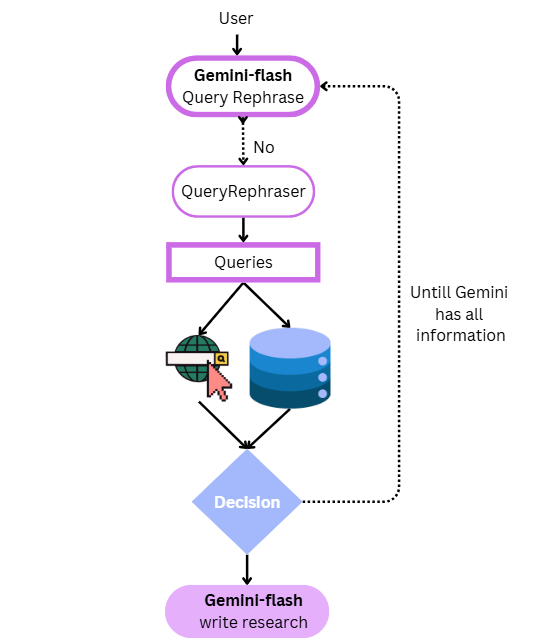Gemini as a Research Agent: Fusion Deep Research for Intelligent Information Retrieval
In today's data-saturated world, effective research isn't just about accessing information—it's about finding the right information efficiently. Let's explore how Gemini can function as a sophisticated research agent, using a fusion deep research approach to intelligently determine what information is necessary and when to search external sources.
Please find the repository here.
The Fusion Deep Research Architecture
The system I've been building employs Gemini 2.0 Flash as an intelligent intermediary between user queries and multiple information sources. This fusion approach combines:
- Local vector database knowledge
- Web-based information retrieval
- Intelligent query reformulation
- Comprehensive information evaluation
Purpose of done flag
The "done": false flag is a crucial control mechanism in the Gemini research agent system. It indicates whether the research process should continue or if sufficient information has been gathered.
Here's a deeper breakdown of how it works:
Purpose of the "done" Flag
The "done" flag serves as the agent's decision-making output that determines whether:
How the Agent Sets This Flag
After each research iteration, Gemini evaluates the collected information against specific criteria:
CopyBased on this observations, you have two options:
1. Find knowledge gaps that still need to be explored and write 3 different queries that explore different perspectives of the topic. If this is the case set the done flag to False.
2. If there are no more knowledge gaps and you have enough information related to the topic, you dont have to provide any more queries and you can set the done flag to True.
When Gemini sets "done": false, it's essentially saying: "I've analyzed what we know so far, and there are still important aspects of this topic we haven't covered adequately."
Evaluation Criteria
The system uses sophisticated criteria to make this determination:
CopyBefore setting the done flag to true, make sure that the following conditions are met:
1. You have explored different perspectives of the topic
2. You have collected some opposing views
3. You have collected some supporting views
4. You have collected some views that are not directly related to the topic but can be used to
How Fusion Deep Research Works
Let's examine a specific example where a user asks: "What are the differences between SSM models and transformer models?"
Step 1: Query Diversification
When receiving this query, Gemini first analyzes it to create focused search terms. Instead of using the raw query, it generates three distinct perspectives to explore:
{
"querys": [
"Key architectural differences between SSM models and transformer models",
"Computational efficiency comparison between SSM models and transformer models",
"When to use SSM models versus transformer models"
],
"done": false
}
This diversification ensures comprehensive coverage of the topic from multiple angles—a key principle of fusion deep research.
Step 2: Multi-Source Information Gathering
The agent uses a fusion approach to information retrieval, intelligently determining when to: - Query the local vector database for trusted information - Expand to web sources when local information is insufficient
def get_observations(queries: List[str]) -> List[str]:
local_observations = []
web_observations = []
for query in queries:
local_observation = my_store.forward(query)
local_observations.extend(list(local_observation))
if web_search:
web_result = exa.search_and_contents(query, type="auto", text=True, num_results=3)
# Process web results...
This fusion of information sources creates a more robust research foundation.
Step 3: Continuous Knowledge Gap Analysis
After each search iteration, Gemini evaluates the collected information against specific criteria:
Step Number: 1
Searching with queries:
Key architectural differences between SSM models and transformer models
Computational efficiency comparison between SSM models and transformer models
When to use SSM models versus transformer models
Done: False
Importantly, the system doesn't just blindly collect information—it actively identifies knowledge gaps:
Based on this observations, you have two options:
1. Find knowledge gaps that still need to be explored and write 3 different queries that explore different perspectives of the topic. If this is the case set the done flag to False.
2. If there are no more knowledge gaps and you have enough information related to the topic, you dont have to provide any more queries and you can set the done flag to True.
This continuous evaluation represents the "deep" aspect of fusion deep research—digging beyond surface-level information to ensure comprehensive understanding.
Step 4: Multi-Perspective Completion Criteria
Perhaps most impressively, Gemini autonomously determines when sufficient information has been gathered based on robust criteria:
Before setting the done flag to true, make sure that the following conditions are met:
1. You have explored different perspectives of the topic
2. You have collected some opposing views
3. You have collected some supporting views
4. You have collected some views that are not directly related to the topic but can be used to explore the topic further.
This creates a research process that is both broad (multiple perspectives) and deep (thorough exploration of each perspective).
Step 5: Information Synthesis and Report Generation
Once fusion deep research is complete, Gemini synthesizes the collected information into a cohesive report, intelligently blending insights from all sources without explicitly highlighting their origins:
Do not explicitly mention if the output is from local or web observations. Just write the report as if you have all the information available.
This seamless integration of multiple information sources is the culmination of the fusion deep research approach.
Why Fusion Deep Research Matters
Traditional research methods often: - Rely too heavily on a single information source - Miss important perspectives - Require manual reformulation of queries - Don't know when "enough is enough" - Need Evaluation setup manually
By implementing fusion deep research with Gemini as an intelligent agent, we transform research from a mechanical process into an adaptive methodology that:
- Ensures comprehensive coverage through multiple information sources
- Identifies and fills knowledge gaps through intelligent query reformulation
- Balances efficiency and thoroughness by prioritizing local knowledge before web searches
- Delivers multi-perspective insights rather than single-viewpoint information
- Knows when to stop searching based on sophisticated completion criteria
Building Your Own Fusion Deep Research System
The implementation requires:
- A vector database for local document storage
- Access to Gemini API (specifically gemini-2.0-flash)
- A web search API (the example uses Exa)
- Clear evaluation criteria for information sufficiency
The most critical component is the prompt engineering that enables Gemini to make intelligent decisions about information adequacy and query formulation within the fusion deep research framework.
Conclusion
As information continues to expand exponentially, fusion deep research represents the future of intelligent information retrieval. By combining multiple information sources with sophisticated evaluation criteria and autonomous decision-making about research sufficiency, we can dramatically improve both the efficiency and quality of our research processes.
Gemini's ability to act as an intelligent intermediary in the fusion deep research process—reformulating queries, evaluating information completeness across sources, and knowing when to stop—transforms it from a mere language model into a true research assistant. As these systems evolve, they promise to redefine how we interact with the growing sea of information around us, making fusion deep research an essential tool for knowledge workers across all domains.
Please find the repository here.
Please give a ⭐ to our repo.

